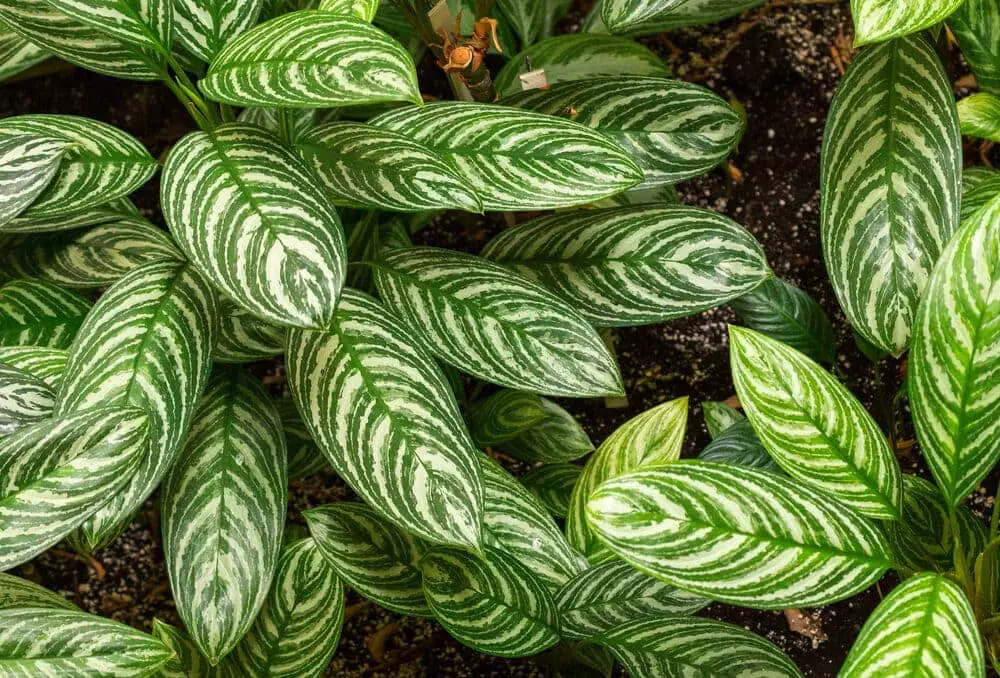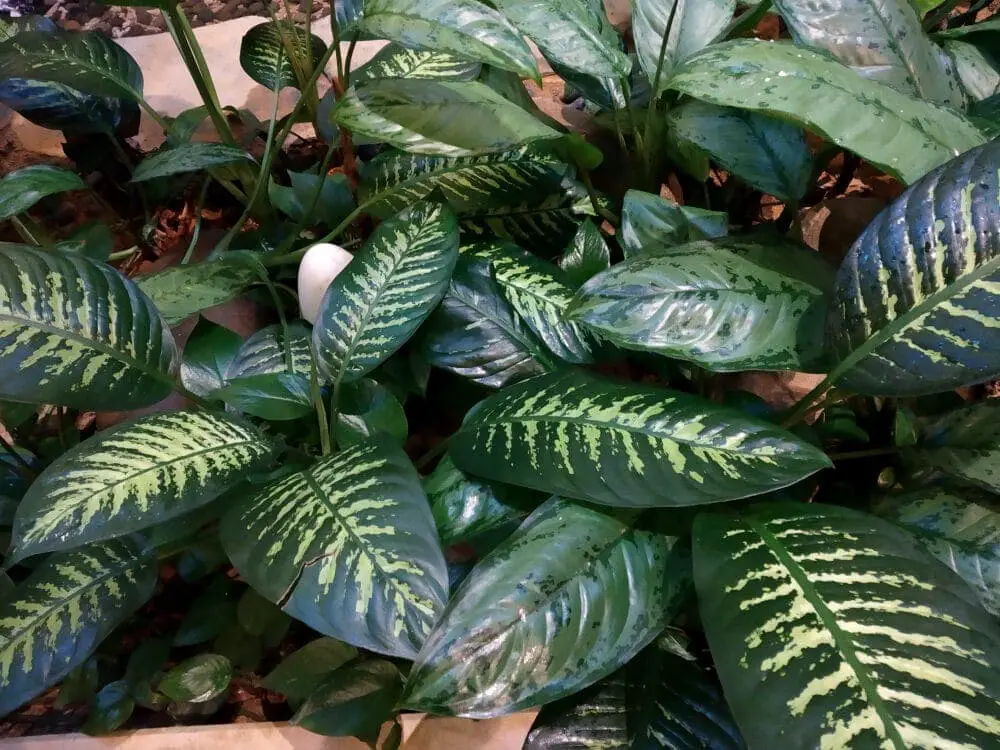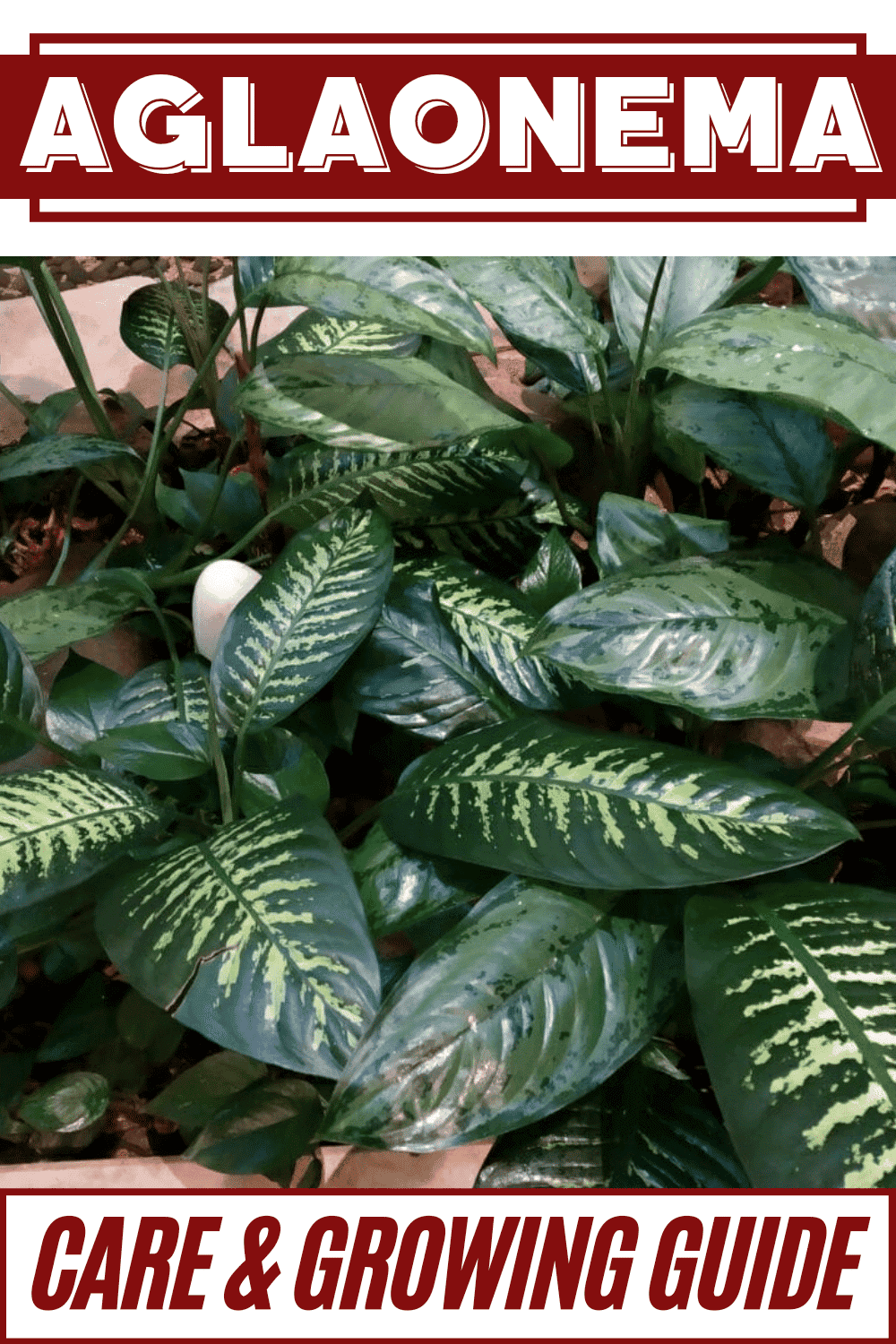The Aglaonema plant is a very decorative Chinese evergreen that comes in several interesting varieties from silver to dark green with some of them having hints of red.
Some say that the Aglaonema plant is easy to grow while others say it is difficult. One simple rule to remember is that the lighter the variegation, the more light the plant will need.
Aglaonema Care & Growing Guide
1. Light Requirement
Depending on the variety of the Aglaonema plant, the plant needs low to bright light. The variegated varieties of the Aglaonema plant need brighter light than the darker green varieties, which can grow in near shade. You should not expose any variety of the Aglaonema plant to direct sunlight.
2. Water
During the summer you need to thoroughly water the plant and mist it often to help raise the humidity. In the winter, you can reduce the watering but you have to make sure that you do not let it dry out completely.
The water should not be tap water because of the minerals but should be water that is well-settled and soft. It should not be lower than room temperature
3. Climate
USDA Hardiness Zone 10-11.
4. Soil
To grow, it needs to have potting soil that is well-draining and is lightly acidic. You should feed your plant with liquid fertilizer or slow-release pellets during the growing season.
5. Temperature
This plant does not like temperatures below 65 degrees Fahrenheit or any cold drafts. Keep the plant away from drafty vents and windows. Because it has high humidity requirements, there are some growers that feel it is a greenhouse plant.

6. Repotting
Aglaonema plants are not usually repotted but if you do, it is done to divide the plants for repotting to start new plants. When you repot your Aglaonema, chop the stems that have gotten leggy. Root the stem in water or soil. Do not put your stem in too much soil as it can encourage rot root before it really has time to develop roots. The soil should be a mixture of 2:1 mix of perlite to potting soil. Once it has started to take roots, you can transfer it to a regular pot. The transplanting should take place every two to three years because of their slow growth.
7. Speed of Growth
The Aglaonema plant is slow growing.
8. Height and Spread
The mature size of the Aglaonema ranges from 10-48 inches tall and wide.
9. Flowers
The flowers are white with large, oval, narrow, and glossy leaves on short stems. It blooms during the spring and summer.
10. Trimming
In order to keep your Aglaonema plant bushy and full as it should look, make sure to remove some of the new leaves when they appear. Grasp the stem with the new leaf growing from. Hold the new leaf near the base and gently pull. It should come out entirely, which it is supposed to do. Make sure that you do not use scissors or anything to cut them out. There should be no stump left behind.
If you use anything to cut them, you could leave a wound on the plant. This would allow for a disease to enter, which can attract insects. Make sure that you remove bracts and flowers by hand but do not cut them either.
Is Aglaonema Poisonous?
Yes, the Aglaonema plant is toxic to animals and humans. When handling the plants, you should wear gloves to protect your skin from irritation. If the plant is ingested it can cause stomach and mouth irritation and maybe vomiting.

Can Aglaonema grow in Water?
Yes, you can take the stems of the Aglaonema plant and start them in water until the roots start growing. Then you can plant them in the ground.
How to get Aglaonema to Flower?
You can get your Aglaonema to grow by fertilizing your plant once time a month during the growing season, which is spring through summer. The fertilizer should be a balanced, water-soluble fertilizer that is formulated for evergreen houseplants. You also need to make sure that it has the right light, temperature, and water.
More like this: Elephant Bush (Portulacaria Afra) Care & Growing Guide
Common Plant Diseases
Aglaonema is prone to a variety of diseases, including:
- Root or stem rot—this can happen if it is over-watered so watch how much water you give your Aglaonema plant.
- Mealy bugs—these are usually found under the leaves or in the axils of the leaf. The bugs give out a sticky substance. They can be removed by lightly spraying it with a Neem oil or a soapy water mixture. You can apply it to the lower and top of the leaf and stem surfaces. You can either spray them or take a sponge moistened with the spray to wipe off the leaves and stems.
- Pythium—this is a common root problem that happens when the soil does not drain correctly or very wet conditions.
- Colletotrichum and Myrothecium—during propagation they can lead to leaf spot. To take care of this issue, cut off and dispose of any of the infected leaves or just the part that is infected. Once this is done, spray the plant with a fungicide until the leaves are dripping wet.
Also read:
Conclusion
- There are about 21 species of the Aglaonema plant.
- This plant is usually grown in planters and put outdoors to give the area a tropical look.
- You should wipe the leaves with a moistened cloth to remove and dirt or dust that might have accumulated occasionally.
- In China, the Aglaonema plant is considered lucky.
- It is considered a clean air plant because being a Chinese evergreen, it has the natural ability to remove formaldehyde and benzene from the air.
- Because it is a clean air plant, it may one day be grown in space.
- The leaves have some type of pattern on them.
- Some of the different types include the Red Gold, Silver Bay, Silver Queen, Emerald Beauty, and Golden Bay.
- Because the Aglaonema can grow in low light, they are great for an office that uses fluorescent lights and are windowless.

Victoria is the owner and main author of hobby plants. She loves spending her free time in her garden planting and taking care of her plants. Victoria hopes you enjoy the content here!
![Queen Of The Night Flower [Complete Plant Care Guide] Queen Of The Night Flower [Complete Plant Care Guide]](https://www.hobbyplants.com/wp-content/uploads/2022/07/queen-of-the-night-flower-300x158.jpg)
![Mother Of Thousands Plant [Complete Plant Care Guide] Mother Of Thousands Plant [Complete Plant Care Guide]](https://www.hobbyplants.com/wp-content/uploads/2022/07/mother-of-thousands-plant-300x158.jpg)
![How Often Should You Water Pothos? [Complete Care Guide] How Often Should You Water Pothos? [Complete Care Guide]](https://www.hobbyplants.com/wp-content/uploads/2022/07/how-often-to-water-pothos-300x158.jpg)
![Can Snake Plants Live Outside? [COMPLETE CARE GUIDE] Can Snake Plants Live Outside? [COMPLETE CARE GUIDE]](https://www.hobbyplants.com/wp-content/uploads/2022/08/can-snake-plants-live-outside-300x158.jpg)
![Majesty Palm Plant Care: [Complete Beginner's Guide] Majesty Palm Plant Care: [Complete Beginner's Guide]](https://www.hobbyplants.com/wp-content/uploads/2022/08/majesty-palm-care-300x158.jpg)
![Exotic Angel Plant Care: [Complete Beginner's Guide] Exotic Angel Plant Care: [Complete Beginner's Guide]](https://www.hobbyplants.com/wp-content/uploads/2022/08/exotic-angel-plant-care-300x158.jpg)
![Do Coleus Like Sun Or Shade: [Complete Care Guide] Do Coleus Like Sun Or Shade: [Complete Care Guide]](https://www.hobbyplants.com/wp-content/uploads/2022/08/coleus-sun-or-shade-300x158.jpg)
![Snow White Waffle Plant: [Complete Care Guide] Snow White Waffle Plant: [Complete Care Guide]](https://www.hobbyplants.com/wp-content/uploads/2022/08/snow-white-waffle-plant-300x158.jpg)
![Waffle Plant Care: [Complete Beginner's Guide] Waffle Plant Care: [Complete Beginner's Guide]](https://www.hobbyplants.com/wp-content/uploads/2022/08/waffle-plant-300x158.jpg)
![Bird Of Paradise Plant Care: [Complete Beginner's Guide] Bird Of Paradise Plant Care: [Complete Beginner's Guide]](https://www.hobbyplants.com/wp-content/uploads/2022/08/bird-of-paradise-plant-300x158.jpg)
![Purple Passion Plant Care: [Complete Beginner's Guide] Purple Passion Plant Care: [Complete Beginner's Guide]](https://www.hobbyplants.com/wp-content/uploads/2022/08/purple-passion-plant-care-300x158.jpg)
![China Doll Plant Care: [Complete Beginner's Guide] China Doll Plant Care: [Complete Beginner's Guide]](https://www.hobbyplants.com/wp-content/uploads/2022/09/china-doll-plant-care-300x158.jpg)